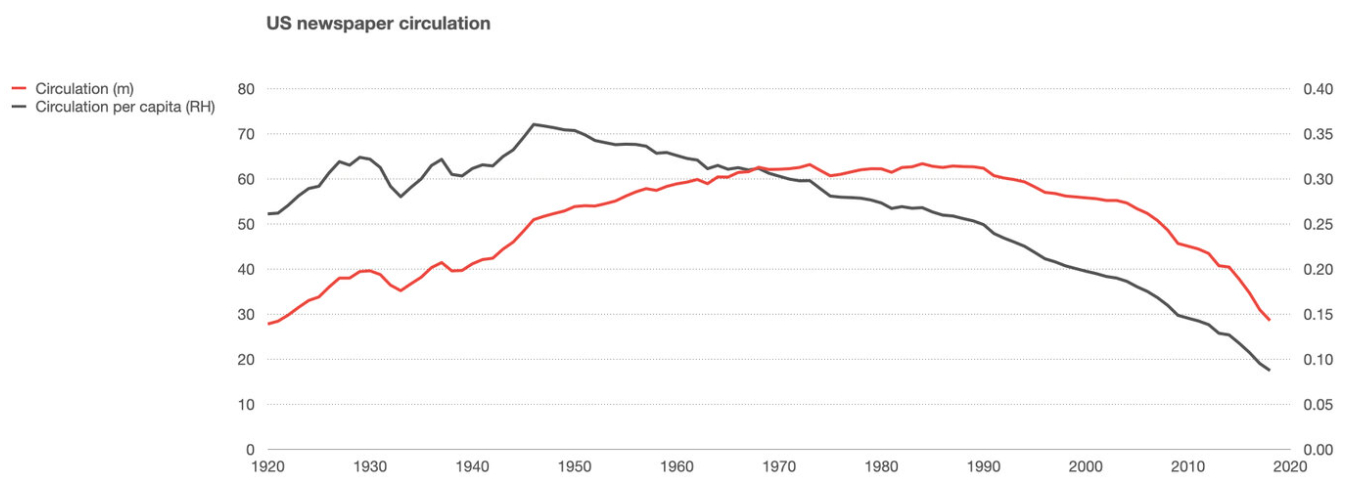
Sponsored By: Brilliant
Worried about AI stealing your job? Stay one step ahead with Brilliant's bite-sized interactive lessons.
It sure does feel like the media industry is having a moment. The moment is a funeral, but still, you know, that is a moment. Vice has swung from a $5.7B valuation to declaring bankruptcy. Buzzfeed shut down its news division and is doing layoffs. Disney laid off 7K employees, News Corp, 1,250.
Despite the setbacks, I still love the industry. On the high end, there are some companies that have done exceptionally well, such as the NFL, a24, The New York Times, and Netflix. Closer to home, I find inspiration in successful micro-publishers like Ben Thompson or other newsletters on Substack making millions with one or two employees.
So what gives? How can this industry that is so lucrative for a few be terrible for so many?
To understand why, I’ve talked with dozens of media industry participants. Over coffee in Brooklyn, Zoom calls in Australia, and bars serving drinks somehow infused with mushrooms in San Francisco, I’ve chatted with everyone from media investors managing $1B+ funds to small digital publishers with less than a thousand subscribers. I’ve thought and read and analyzed for months to try to synthesize what everyone is telling me. Today’s post is the result of that work.
The TL;DR is this: Consumers don’t want to pay you, Facebook is better at advertising, and unique distribution is necessary for long-term survival but almost impossible to get. If you somehow get an audience, congrats! Your reward is a million competitors who are constantly trying to kill you and steal your audience. Still, if you are able to climb up the power law, you may be able to build long-term success.
In honor of my recently laid-off writer comrades, I have structured my arguments into a Buzzfeed style list:
1) Media companies are always the shit eater of consumer tech
Over the past 10 years of building, a media company has been subject to the following technological shifts: newsfeed pivots, the depreciation of cookies, Apple’s App Tracking Transparency policy, platform-specific article formats, Web3, long-form video, the rise of TikTok, and now, GenerativeAI. Each and every one of these trends merits a reinvention of a media business, but most importantly, a media company didn’t invent or control any of these. All of these were enabled by science but implemented by big tech.
For every single evolution of technology since the internet, content creation companies have been moved to the role of commodity supplier. As technology changes the types of popular supply, a media company is forced to alter its product or be left in the dust. To be a media company is to never be in control of your distribution and to be subject to the winds of progress on a daily basis.
2) The internet broke media businesses, not social platforms
Prior to the internet, both content creation and distribution were limited. The physical costs of production/distribution were too much—printing presses, TV studio cameras—and required upfront capital. There were a limited number of content creators and a limited number of distributors. At every step of the process, there were powerful, profit-extracting gatekeepers. From the 1920s to 1940s, newspapers and radio were essentially the only content game in town. They had powerful regional monopolies, exclusive reporting, and a stranglehold on local advertising. The past 80 years has seen more and more distributors and content creators come along. The newspaper industry’s revenue collapsed:
It also happened on a distribution per capita—newspaper circulation have been declining since 1950.
I know it is tempting to blame our lizard people overlords (looking at you, Elon) for the media's struggles, but that isn’t the case. Facebook, Twitter, and YouTube are just manifestations of the power of infinite, global, and free distribution that the internet provides. Plus, newspapers began to decline far before that.
Some content distribution rails are better than others (which is why we post these essays on our own site and distribute it through email), but the internet is the root of the problem. Major technology shifts take a long time to permeate through society, and we are still very much in the early stages of the internet. Shoot, cloud software, which is much more obvious to scale/spend has been around since 1999, and is still only 15% of IT spend. Information technology is still on a multi-decade journey and media companies are just along for the ride.
3) Customers have the mental focus of a goldfish
The Only Subscription
You Need to
Stay at the
Edge of AI
The essential toolkit for those shaping the future
"This might be the best value you
can get from an AI subscription."
- Jay S.
Join 100,000+ leaders, builders, and innovators

Email address
Already have an account? Sign in
What is included in a subscription?
Daily insights from AI pioneers + early access to powerful AI tools












Comments
Don't have an account? Sign up!
I'd say media is by FAR the worst industry to be a mid-level or even mid-senior level player in--just permanent Stockholm Syndrome. But if you can somehow hit professional lotto and make it to the top, whether as a Ben Thomposon style who bags millions to think out loud, or as like an old guard cable exec, it's the best industry to be in. One of the most powerful businessman in the world can literally spend his day building rockets yet his heart and head are still more drawn to his fucked up little media toy :)